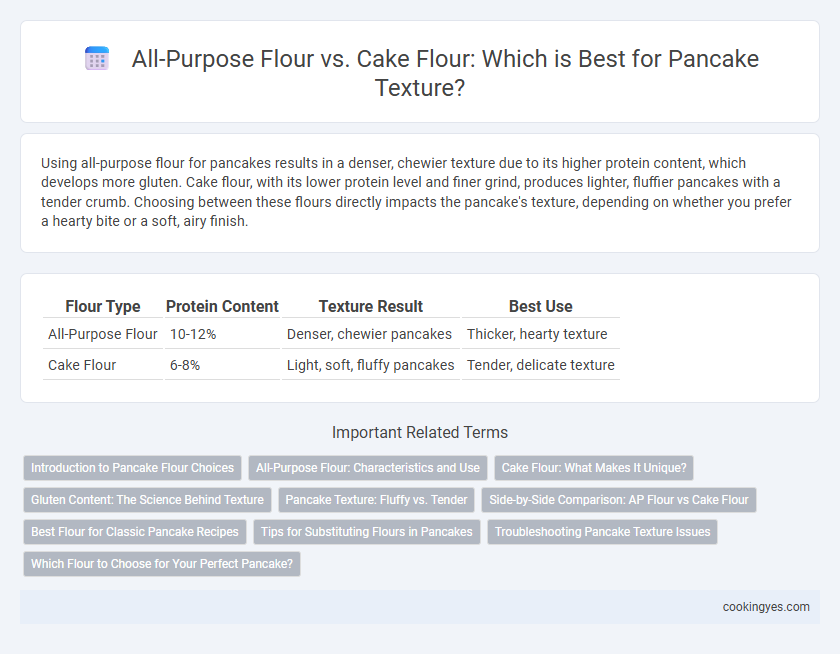Using all-purpose flour for pancakes results in a denser, chewier texture due to its higher protein content, which develops more gluten. Cake flour, with its lower protein level and finer grind, produces lighter, fluffier pancakes with a tender crumb. Choosing between these flours directly impacts the pancake's texture, depending on whether you prefer a hearty bite or a soft, airy finish.
Table of Comparison
| Flour Type | Protein Content | Texture Result | Best Use |
|---|---|---|---|
| All-Purpose Flour | 10-12% | Denser, chewier pancakes | Thicker, hearty texture |
| Cake Flour | 6-8% | Light, soft, fluffy pancakes | Tender, delicate texture |
Introduction to Pancake Flour Choices
All-purpose flour and cake flour differ in protein content, significantly impacting pancake texture. All-purpose flour, with higher protein levels, creates a denser and chewier pancake, while cake flour's lower protein yields lighter, fluffier results. Choosing the right flour depends on the desired pancake texture, balancing structure and tenderness.
All-Purpose Flour: Characteristics and Use
All-purpose flour, with a moderate protein content of 10-12%, provides a balanced structure ideal for pancakes, contributing to a slightly denser but sturdier texture compared to cake flour. Its versatility allows for a reliable rise and a tender crumb while maintaining enough gluten strength to support flipping and holding fillings or toppings. This type of flour is preferred for classic, fluffy pancakes that require a good balance between softness and chewiness.
Cake Flour: What Makes It Unique?
Cake flour contains a lower protein content, typically around 7-9%, which results in less gluten formation and a softer, more tender pancake texture. Its finer milling process and bleached nature enhance moisture absorption and create lighter, fluffier pancakes with a delicate crumb. This unique composition makes cake flour ideal for achieving the airy, melt-in-your-mouth consistency preferred in premium pancakes.
Gluten Content: The Science Behind Texture
All-purpose flour contains 10-12% gluten, providing a balanced structure that results in pancakes with a slightly chewy and sturdy texture. Cake flour, with its lower gluten content of about 7-9%, produces lighter, tender, and fluffier pancakes by creating a softer crumb. Understanding the gluten levels allows bakers to choose the appropriate flour based on desired pancake texture, blending strength and tenderness through gluten protein interaction.
Pancake Texture: Fluffy vs. Tender
All-purpose flour produces pancakes with a denser, fluffier texture due to its moderate protein content, which creates more gluten structure. Cake flour, with its lower protein level, yields a softer, more tender pancake that is delicate and light. Choosing between these flours depends on whether a fluffy or tender pancake texture is preferred.
Side-by-Side Comparison: AP Flour vs Cake Flour
All-purpose flour provides pancakes with a balanced texture, offering moderate protein content (10-12%) that creates a slightly denser and chewier bite. Cake flour, with its lower protein content (6-8%) and finer milling, produces lighter, tender pancakes with a more delicate crumb. Choosing cake flour results in fluffier pancakes, while all-purpose flour ensures a sturdier, more substantial texture.
Best Flour for Classic Pancake Recipes
All-purpose flour and cake flour differ primarily in protein content, with all-purpose containing 10-12% protein and cake flour around 7-8%, affecting pancake texture. Classic pancake recipes benefit from all-purpose flour due to its balanced gluten development, producing a sturdier yet tender texture ideal for flipping and absorbing syrup. Cake flour yields softer, finer pancakes but may result in a more delicate structure that can be less resilient during cooking.
Tips for Substituting Flours in Pancakes
Using all-purpose flour in pancakes results in a denser, chewier texture due to higher protein content, whereas cake flour, with its lower protein, produces softer and fluffier pancakes. When substituting cake flour for all-purpose, add 2 tablespoons of cornstarch per cup of cake flour to replicate tenderness, or sift flour multiple times to aerate the batter. For a balanced texture, combine 75% all-purpose flour with 25% cake flour, enhancing pancake fluffiness without compromising structure.
Troubleshooting Pancake Texture Issues
Using all-purpose flour in pancakes typically results in a denser, chewier texture due to its higher protein content, while cake flour produces lighter, fluffier pancakes because of its lower protein and finer grind. Troubleshooting dense or rubbery pancakes often involves adjusting the flour type, ensuring proper measurement, and avoiding overmixing the batter to prevent gluten overdevelopment. For optimal pancake texture, consider substituting cake flour or a blend of cake and all-purpose flour to balance tenderness and structure.
Which Flour to Choose for Your Perfect Pancake?
All-purpose flour contains a moderate protein content of around 10-12%, providing a balanced structure that yields fluffy yet slightly dense pancakes, ideal for those preferring a classic texture. Cake flour, with its lower protein content of 7-8%, produces lighter and softer pancakes due to its finer grind and lower gluten formation, perfect for delicate, tender stacks. Choosing between all-purpose and cake flour depends on whether you want a sturdy, slightly chewy pancake or a melt-in-your-mouth softness.
All-Purpose Flour vs Cake Flour for Pancake Texture Infographic

 cookingyes.com
cookingyes.com